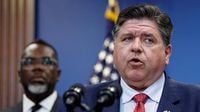On the streets of Chicago, a storm has been brewing for months. Federal immigration enforcement has come to define daily life for thousands of residents, with the city’s neighborhoods transformed into battlegrounds between local officials, community members, and the aggressive tactics of U.S. Immigration and Customs Enforcement (ICE) and Border Patrol agents. The latest escalation—tear gas deployed during a children’s Halloween parade—has brought the city’s simmering tensions to a boil and thrust Illinois Governor J.B. Pritzker into the national spotlight as a leading critic of President Donald Trump’s immigration crackdown.
According to Military.com, the chaos unfolded on the weekend of October 25-26, 2025, in Chicago’s Avondale and Old Irving Park neighborhoods. Illinois State Senator Graciela Guzman described a harrowing scene: “Over the course of 20-25 minutes, there were multiple detentions by ICE,” she recounted. “In a 25-minute span, there were three independent uses of tear gas in my district and my community.” Guzman, alongside her staff and roughly 15-20 community members, was tear gassed while attempting to question ICE agents about their presence and tactics. The agents, she said, left without providing any explanation.
The Department of Homeland Security (DHS) offered a different account. Assistant Secretary Tricia McLaughlin explained that Border Patrol agents had arrested a “criminal illegal alien” from Mexico who had previously been charged with assault. According to McLaughlin, the agents faced a hostile crowd and, after “multiple lawful commands and verbal warnings [were] ignored,” deployed crowd control measures to clear the area. She added, “If you lay a hand on a law enforcement officer, you will be prosecuted to the fullest extent of the law.”
This incident was just the latest in a series of confrontations that have left residents feeling under siege. Chicago Alderman Andre Vasquez, chair of the Committee on Immigrant Refugee Rights, told Military.com that ICE activity has intensified, with agents detaining day laborers and appearing on residential streets. “It’s very Gestapo tactics, very secret police [type behavior] going on,” Vasquez said. “You’ve got unidentified folks doing it, and so the activity has increased.”
Community response has been swift. Rapid-response networks and defense workshops have sprung up, drawing hundreds of residents determined to protect their neighbors. Yet the fear is palpable. Vasquez described a climate of exhaustion and wariness: “It’s a political attack on multiple fronts that we’re watching happen in real time.” He and Guzman estimate that over 3,000 individuals have been detained across Illinois in recent months, with some effectively “missing” and untraceable.
At the center of the storm is Governor J.B. Pritzker, who has emerged as one of the most vocal opponents of the Trump administration’s immigration policies. Pritzker, in interviews with MSNBC and other outlets, has not minced words. He’s mocked President Trump’s threats to jail him—"Come and get me, Mr. President!"—and called on Illinoisans to document ICE targeting of black and brown people. With the threat of federal troops being deployed to Chicago’s streets, Pritzker has sought to reduce fear and trauma among his constituents, warning that Trump may use the military to interfere in the 2026 election.
Pritzker’s concerns are grounded in the lived experiences of his constituents. “People are traumatized,” he said, recalling visits to local schools where children fear coming home to find their parents gone. “If you have brown skin or black skin, you are literally afraid that you are going to get pulled over or detained walking down the street just for being brown or black.” He described ICE and Border Patrol agents “marching in uniform with semiautomatic or automatic weapons in the streets of downtown Chicago,” using unmarked vehicles and masked agents to conduct raids not only in the city but also in the suburbs.
The governor has encouraged residents to record and publicize ICE actions, arguing that public documentation is crucial for future accountability. “I’ve asked people all over the city of Chicago and we’ve used also our state resources to video as many things as we see that ICE are doing and that CBP is doing to the people of Chicago that we think are illegal,” Pritzker explained to MSNBC. “Making a record and actually asking for people to submit testimony about that. … There will be a moment when these folks are held accountable.”
Yet holding federal agents accountable is a legal labyrinth. Stephen Miller, former White House Deputy Chief of Staff and architect of Trump’s immigration policies, recently told Fox News that ICE agents have “federal immunity in the conduct of your duties. And anybody who lays a hand on you or tries to stop or obstruct you is committing a felony.” Miller even accused Governor Pritzker of “seditious conspiracy” for attempting to block federal deportation efforts and threatened his arrest.
Legal experts, however, dispute the notion of blanket immunity. Stephen Vladeck, a Georgetown University law professor, explained in his newsletter that “the federal government absolutely retains the ability to prosecute federal law enforcement officers who break the law, even in the course of carrying out their duties.” The doctrine of “Supremacy Clause immunity” protects federal officers from state prosecution only when their actions are “necessary and proper” under federal law and deemed reasonable. “Even at its most robust, Supremacy Clause immunity would not preclude a local or state prosecution of ICE officers for all scope-of-employment conduct,” Vladeck wrote. Other legal voices, such as appellate lawyer Howard Bashman, have echoed this view, emphasizing that Miller’s claims are “overstated at best.”
Some local officials are testing these limits. Democratic Rep. Dan Goldman sent a letter to New York City Police Commissioner Jessica Tisch, urging NYPD officers to be trained to arrest and prosecute federal agents who break state laws. San Francisco District Attorney Brooke Jenkins has also pledged to review and potentially file charges for “clear, excessive use of force” by federal agents.
Meanwhile, the human toll in Chicago continues to mount. Governor Pritzker has repeatedly highlighted the psychological impact on children and families. He described a military-style raid in which “many of whom were U.S. citizens were detained for hours, put into U-Hauls, little kids zip tied, and they used Blackhawk helicopters repelling out of the helicopters.” Community leaders like Jesse Fuentes have confronted ICE agents directly, demanding judicial warrants and defending residents’ constitutional rights—sometimes resulting in their own detention.
Pritzker has drawn historical parallels, invoking Pastor Martin Niemöller’s poem “First They Came” and warning of the dangers of authoritarianism. “Authoritarianism, which [Holocaust survivors] easily recognize the early stages of, is coming upon this country and that people are beginning to wake up and recognize it,” he told MSNBC. Still, he remains hopeful that public resistance and documentation will ultimately bring accountability.
As Chicago’s neighborhoods brace for what comes next, the city stands as a microcosm of the national debate over immigration, law enforcement, and democracy itself. The battle lines are drawn—not just in courtrooms and legislative chambers, but on the very streets where children play and families live in fear.
For now, Chicago’s residents and leaders continue to push back, determined to ensure that their city’s story is told—and that the rights of all its people are defended, no matter how fierce the opposition.

